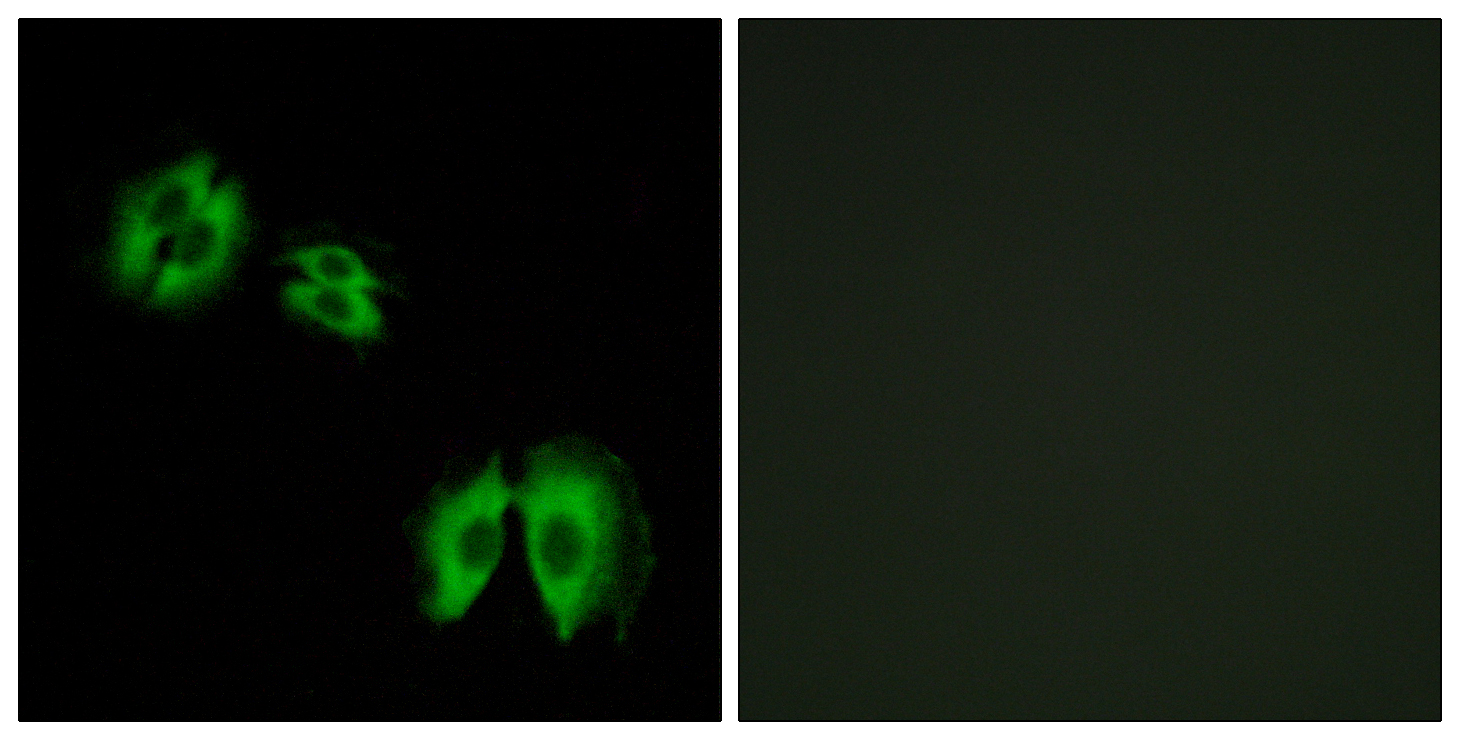β-1,3-Gal-T2 Polyclonal Antibody
- Catalog No.:YT5003
- Applications:IHC;IF;ELISA
- Reactivity:Human;Mouse
- Target:
- β-1,3-Gal-T2
- Fields:
- >>Glycosphingolipid biosynthesis - lacto and neolacto series;>>Metabolic pathways
- Gene Name:
- B3GALT2
- Protein Name:
- Beta-1,3-galactosyltransferase 2
- Human Gene Id:
- 8707
- Human Swiss Prot No:
- O43825
- Mouse Gene Id:
- 26878
- Mouse Swiss Prot No:
- O54905
- Immunogen:
- The antiserum was produced against synthesized peptide derived from human B3GALT2. AA range:373-422
- Specificity:
- β-1,3-Gal-T2 Polyclonal Antibody detects endogenous levels of β-1,3-Gal-T2 protein.
- Formulation:
- Liquid in PBS containing 50% glycerol, 0.5% BSA and 0.02% sodium azide.
- Source:
- Polyclonal, Rabbit,IgG
- Dilution:
- IHC 1:100 - 1:300. IF 1:200 - 1:1000. ELISA: 1:40000. Not yet tested in other applications.
- Purification:
- The antibody was affinity-purified from rabbit antiserum by affinity-chromatography using epitope-specific immunogen.
- Concentration:
- 1 mg/ml
- Storage Stability:
- -15°C to -25°C/1 year(Do not lower than -25°C)
- Other Name:
- B3GALT2;Beta-1;3-galactosyltransferase 2;Beta-1,3-GalTase 2;Beta3Gal-T2;Beta3GalT2;UDP-galactose:2-acetamido-2-deoxy-D-glucose 3beta-galactosyltransferase 2
- Molecular Weight(Da):
- 49kD
- Background:
- This gene is a member of the beta-1,3-galactosyltransferase (beta3GalT) gene family. This family encodes type II membrane-bound glycoproteins with diverse enzymatic functions using different donor substrates (UDP-galactose and UDP-N-acetylglucosamine) and different acceptor sugars (N-acetylglucosamine, galactose, N-acetylgalactosamine). The beta3GalT genes are distantly related to the Drosophila Brainiac gene and have the protein coding sequence contained in a single exon. The beta3GalT proteins also contain conserved sequences not found in the beta4GalT or alpha3GalT proteins. The carbohydrate chains synthesized by these enzymes are designated as type 1, whereas beta4GalT enzymes synthesize type 2 carbohydrate chains. The ratio of type 1:type 2 chains changes during embryogenesis. By sequence similarity, the beta3GalT genes fall into at least two groups: beta3GalT4 and 4 other beta3
- Function:
- cofactor:Manganese.,function:Beta-1,3-galactosyltransferase that transfers galactose from UDP-galactose to substrates with a terminal beta-N-acetylglucosamine (beta-GlcNAc) residue. Can also utilize substrates with a terminal galactose residue, albeit with lower efficiency. Involved in the biosynthesis of the carbohydrate moieties of glycolipids and glycoproteins. Inactive towards substrates with terminal alpha-N-acetylglucosamine (alpha-GlcNAc) or alpha-N-acetylgalactosamine (alpha-GalNAc) residues.,online information:Beta-1,3-galactosyltransferase 2,online information:GlycoGene database,pathway:Protein modification; protein glycosylation.,similarity:Belongs to the glycosyltransferase 31 family.,tissue specificity:Detected in heart and brain.,
- Subcellular Location:
- Golgi apparatus membrane ; Single-pass type II membrane protein .
- Expression:
- Detected in heart and brain.
- June 19-2018
- WESTERN IMMUNOBLOTTING PROTOCOL
- June 19-2018
- IMMUNOHISTOCHEMISTRY-PARAFFIN PROTOCOL
- June 19-2018
- IMMUNOFLUORESCENCE PROTOCOL
- September 08-2020
- FLOW-CYTOMEYRT-PROTOCOL
- May 20-2022
- Cell-Based ELISA│解您多样本WB检测之困扰
- July 13-2018
- CELL-BASED-ELISA-PROTOCOL-FOR-ACETYL-PROTEIN
- July 13-2018
- CELL-BASED-ELISA-PROTOCOL-FOR-PHOSPHO-PROTEIN
- July 13-2018
- Antibody-FAQs
- Products Images

- Immunofluorescence analysis of A549 cells, using B3GALT2 Antibody. The picture on the right is blocked with the synthesized peptide.

- Immunohistochemistry analysis of paraffin-embedded human heart tissue, using B3GALT2 Antibody. The picture on the right is blocked with the synthesized peptide.



